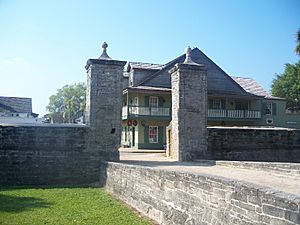Cubo Line facts for kids
Quick facts for kids Cubo Line |
|
|---|---|
| Linea Cubo | |
| St. Augustine, Florida | |

City gates in the Cubo Line
|
|
| Type | Defensive line |
| Height | 6 feet (1.8 m) |
| Site information | |
| Open to the public |
Yes |
| Condition | Most of wall has disappeared, short section reconstructed; coquina gate pillars still exist |
| Site history | |
| Built | 1702–1716 |
| In use | 1704–1821 |
| Materials | Earth, palmetto logs, coquina rock |
| Battles/wars | Siege of St. Augustine (1740) Patriot War of East Florida (1812) |
The Cubo Line was a defensive wall built by the Spanish. It helped protect the important Spanish town of St. Augustine in Spanish Florida during the early 1700s. This line was part of a bigger defense system. It kept the town safe from attacks by land.
Contents
Protecting St. Augustine: Why the Cubo Line Was Built
In 1702, St. Augustine was attacked and burned by English troops. These troops were led by James Moore, the governor of the English colony of Carolina. After this attack, the Spanish decided they needed better defenses. They wanted to protect St. Augustine even more, especially outside their big stone fort, the Castillo de San Marcos.
Building the First Cubo Line
The English had entered St. Augustine easily because the town was on a narrow piece of land. So, in 1704, Governor José de Zúñiga ordered a new defense system. This system would protect the town's open sides from future invasions. By 1705, the Cubo Line was ready.
It was an earth wall covered with sharp yucca plants. Behind this, there was a nine-foot-tall fence made of palm logs. This wall stretched for about half a mile. It went from the Castillo de San Marcos fort to the San Sebastian River. The Cubo Line marked the northern edge of St. Augustine.
Features of the Cubo Line
The Cubo Line had six small forts called redoubts. A wide ditch, about 40 feet across, ran next to the wall. There was also a small drawbridge over the ditch at the town's main gate. This made it harder for enemies to get in.
Other Defensive Walls Around St. Augustine
The Cubo Line was not the only defense. The Spanish built other walls to protect St. Augustine.
The Hornabeque Line
In 1706, work started on another wall. It was about half a mile north of the Cubo Line. This was called the Hornabeque Line. It had "horns" or demi-bastions that stuck out like bull horns at each end.
The Rosario Line
In 1718, the Rosario Line was built. This wall ran south from the Santo Domingo Redoubt for almost a mile. Then it turned east towards Matanzas Bay. These inner walls were very important. They stopped General James Oglethorpe from taking St. Augustine in 1740. Oglethorpe was the governor of the English colony of Georgia.
The Mose Line
The Mose Line was St. Augustine's outermost defense. It was built much later, in 1762. This was just one year before the Spanish left St. Augustine. They gave the town to the British as part of the Treaty of Paris (1763).
All these defensive lines were about half a mile long or more. Each line was connected to a fort:
- The Cubo and Rosario Lines were linked to the Castillo de San Marcos.
- The Hornabeque Line was linked to Fort Nombre de Dios.
- The Mose Line was linked to Fort Mose.
Changes to the Cubo Line Over Time
The Cubo Line was rebuilt and improved several times.
First Reconstruction (1718–1719)
During its first rebuild, the Cubo Line became an earthwork. It had three redoubts for cannons. These were called Santo Domingo, Medio Cubio, and Cubo.
Later Improvements (1808–1821)
In 1808, the Cubo Line was rebuilt again. Two stone pillars made of coquina rock were added. These pillars supported the wooden gate doors. In 1820, a new royal engineer named Ramón de la Cruz suggested more improvements. These changes were finished by June 1821. This was when Spain officially gave Florida to the United States. This happened because of a treaty called the Adams–Onís Treaty.
At that time, de la Cruz described the Cubo Line. He mentioned the Cubo redoubt and the Middle and Tolomato redoubts. These were the same as the earlier Medio and Santo Domingo redoubts.

